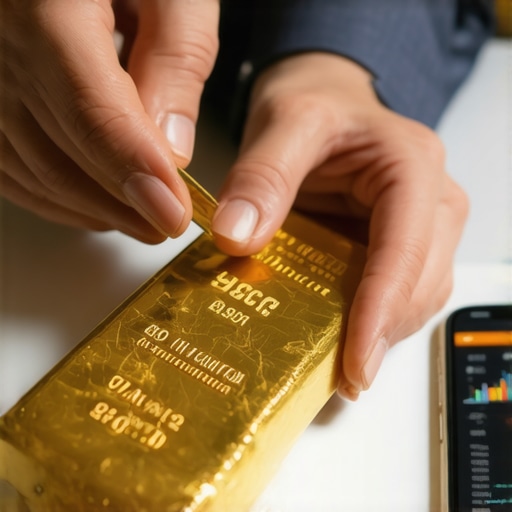Understanding Gold Investment Strategies
Investing in gold has become a significant trend among both novice and experienced investors, particularly as economic uncertainties rise. For beginners, navigating the various gold investment strategies can be daunting. This guide aims to simplify the process, offering insights into evaluating gold investments effectively.
Gold is not just a commodity; it is often viewed as a safe haven asset. Its value tends to rise during economic downturns, making it an attractive option for those looking to diversify their portfolios. Before diving into specific strategies, it’s crucial to understand the different forms of gold investment available.
Types of Gold Investments
When considering gold investments, you can choose between physical gold, gold-backed securities, and gold mining stocks. Each type has its unique characteristics and benefits:
- Physical Gold: This includes gold coins, bars, and jewelry. Investors appreciate the tangible nature of physical gold, but it requires secure storage and insurance.
- Gold ETFs: Exchange-Traded Funds (ETFs) offer an opportunity to invest in gold without the need to store physical assets. These funds track gold prices and can be traded on stock exchanges.
- Gold Mining Stocks: Investing in mining companies can provide exposure to gold prices while also benefiting from the company’s operational efficiency. However, they come with additional risks related to mining operations.
Evaluating Gold Investment Strategies
Evaluating which gold investment strategy suits you best involves assessing your financial goals, risk tolerance, and market conditions. Here are some essential factors to consider:
- Investment Horizon: Are you looking for short-term gains or long-term stability? Gold typically serves as a long-term investment, providing a hedge against inflation and market volatility.
- Market Trends: Understanding gold demand trends can help you make informed decisions. For instance, during times of economic uncertainty, gold demand often increases, driving prices higher. Resources like Understanding Gold Demand Trends can provide insights into market dynamics.
- Cost Considerations: Be aware of the costs associated with different gold investments. Physical gold incurs costs related to storage and insurance, while ETFs may have management fees.
It’s also beneficial to stay informed about global economic indicators that influence gold prices. Factors such as interest rates, inflation rates, and currency strength can all impact your investments. For example, when interest rates are low, gold typically performs well as investors seek alternatives to traditional savings.
As you evaluate your options, consider consulting resources such as Gold Market Analysis for Beginners for a comprehensive understanding of current market conditions. Additionally, exploring How to Successfully Trade Gold can enhance your trading skills and strategies.
In summary, understanding the types of gold investments and evaluating your strategies based on various factors can empower you as an investor. Stay tuned for more insights on specific techniques and strategies to maximize your gold investments in 2025.
Understanding Market Conditions for Gold Investments
As you develop your gold investment strategy, it is crucial to comprehend the prevailing market conditions. Various factors, including geopolitical tensions and economic indicators, can significantly influence gold prices. Investors should keep a close eye on these elements to make informed decisions. For instance, during economic instability, gold often becomes a more attractive investment, leading to increased demand. Engaging with resources like The Role of Gold in a Diversified Investment Portfolio can deepen your understanding of how gold fits into broader market dynamics.
Analyzing Gold Price Trends
Monitoring gold price trends is essential for both short-term and long-term investors. Utilizing tools such as price charts and market analysis reports can help identify patterns and potential future movements. Understanding seasonal trends and historical price behavior also equips investors to anticipate market shifts. For example, gold prices often surge during specific economic cycles, making it vital to analyze resources such as Gold Price Forecast for insights on upcoming fluctuations.
Risk Management in Gold Investments
Effective risk management strategies are crucial when investing in gold. Diversification within your gold portfolio can mitigate risks associated with price volatility. For instance, combining physical gold investments with gold ETFs can provide a balanced approach that leverages the benefits of both asset types. Additionally, understanding how to navigate market downturns by utilizing hedging techniques can safeguard your investments. Resources like How to Harness Gold’s Stability as an Investment Hedge offer valuable strategies for protecting your portfolio.
Timing Your Gold Investments
Timing is a critical aspect of any investment strategy, and gold is no exception. Investors must consider when to enter or exit the market based on their research and analysis. Recognizing signs of market correction or uptrends can enhance your investment outcomes. For example, if gold prices are expected to rise due to inflation concerns, it may be wise to increase your holdings at that time. Staying updated with market news through platforms like 2025 Gold Price Forecast can provide timely information to guide your decisions.
Utilizing Gold ETFs for Flexibility
Gold ETFs have gained popularity among investors due to their flexibility and ease of trading. They offer exposure to gold prices without the complexities of physical ownership. This makes them an attractive option for those who want to invest in gold while maintaining liquidity. However, it’s essential to choose the right ETFs based on their performance, fees, and underlying assets. Resources like Comparing Gold ETFs vs Physical Gold can assist you in making informed decisions about the best investment options for your needs.
Exploring Advanced Gold Investment Options
For those looking to deepen their engagement with gold investments, exploring advanced options such as gold mutual funds and mining stocks can be beneficial. Gold mutual funds offer diversified exposure to gold-related equities, while mining stocks can provide leveraged returns based on gold price movements. However, these options come with their own set of risks and rewards. Understanding the intricacies of these investments is vital, and resources like Investing in Gold Mutual Funds can guide you through the process.
Utilizing Gold Mining Stocks for Greater Returns
Investing in gold mining stocks can offer a unique opportunity to leverage the price movements of gold. Unlike direct investments in physical gold, mining stocks may provide higher returns during bullish gold markets. However, they also come with added risks, including operational challenges and market volatility. For investors considering this path, understanding the underlying factors that influence mining stocks is crucial. Resources such as How to Evaluate Gold Stocks in Today’s Market Environment can help refine your strategy.
Evaluating Mining Companies
When assessing gold mining stocks, investors should focus on the company’s fundamentals. Key metrics include production costs, reserves, and management expertise. Low production costs can enhance profitability, especially in fluctuating markets. Additionally, understanding the geographical location of mining operations can provide insights into potential risks, such as political instability or environmental regulations. For a more in-depth analysis, consider exploring Essential Insights into Gold Stocks.
Investing in Gold Mutual Funds: Diversification Made Easy
Gold mutual funds represent another avenue for investors who prefer a diversified approach to gold investments. These funds pool money from various investors to purchase a range of gold-related assets, including mining stocks, ETFs, and physical gold. By investing in mutual funds, you gain exposure to a broader spectrum of gold investments, which can help mitigate risks associated with individual stocks. For beginners, resources like Investing in Gold Mutual Funds: Tips for Beginners 2025 provide essential insights on how to navigate this investment option.
Understanding Fund Performance
When selecting a gold mutual fund, pay attention to the fund’s historical performance, fees, and management style. Analyze how the fund has reacted to gold price fluctuations in the past to gauge its potential future performance. Moreover, consider the fund’s expense ratio, as lower fees can significantly impact your overall returns over time.
Exploring Gold Futures for Experienced Investors
For those with a higher risk tolerance, gold futures can be an intriguing investment option. Futures contracts allow investors to agree to buy or sell gold at a predetermined price on a future date. This can lead to substantial profits if the market moves in your favor, but it also poses significant risks. Engaging with futures requires a solid understanding of market dynamics and timing. For insights into navigating gold futures, resources like Understanding Gold Futures: Concepts for New Investors are invaluable.
Risk Management in Futures Trading
Effective risk management strategies are paramount when trading gold futures. Techniques such as setting stop-loss orders can help protect your investment from adverse market movements. Additionally, diversifying your trading strategies can provide a buffer against volatility. Maintaining a disciplined approach and regularly reviewing your positions will enhance your chances of success.
Leveraging Gold as a Hedge Against Inflation
Gold has long been viewed as a hedge against inflation, with its value typically rising when purchasing power declines. As inflation rates increase, investors often flock to gold, driving up its price. Understanding the relationship between gold and inflation can help you time your investments more effectively. For an in-depth exploration of this concept, check out How Gold as a Hedge Can Secure Your Financial Future.
Incorporating these advanced strategies into your gold investment approach can not only enhance your potential returns but also help you navigate the complexities of the gold market effectively. As you develop your investment strategy, consider the impacts of global economic conditions, which can significantly influence gold prices. The dynamic nature of the gold market makes continuous learning essential for success.
Mastering Gold Investment Techniques for 2025
As you dive deeper into the gold investment landscape, understanding advanced techniques can empower you to optimize your portfolio. Each investment strategy carries its unique set of advantages and challenges. By mastering these techniques, you can better position yourself to capitalize on market fluctuations and achieve your financial goals.
Utilizing Gold Futures for Strategic Positioning
Gold futures present a fascinating option for investors seeking to profit from anticipated price movements. By agreeing to buy or sell gold at a predetermined price in the future, savvy investors can leverage their positions effectively. However, it’s essential to conduct thorough research and analysis before engaging in futures trading. Resources such as Exploring Gold Futures: Are They Right for You? can provide the insights needed to navigate this complex market.
Understanding Gold Options for Flexibility
Another advanced strategy worth exploring is gold options. These financial instruments give investors the right, but not the obligation, to buy or sell gold at a specified price before a set expiration date. Options can serve as an effective hedge against market volatility while allowing for potential profit opportunities. To grasp the nuances of gold options, consider reviewing Understanding Gold Futures: Concepts for New Investors, which also touches on option strategies that can complement your futures trading.
Investing in Gold Mining ETFs
Gold mining ETFs are an excellent choice for those looking to gain exposure to the gold sector without investing directly in physical gold. These funds invest in companies involved in gold mining, providing an indirect way to benefit from rising gold prices. While mining stocks can be more volatile than physical gold, they often offer higher potential returns during bullish market conditions. Resources such as Gold Stocks vs Mutual Funds: The Smart Investor’s Choice can help you understand the nuances of mining investments.
Evaluating the Mining Sector
When investing in gold mining ETFs, it’s crucial to evaluate the underlying companies’ performance and market conditions. Pay attention to factors such as production costs, geopolitical risks, and management effectiveness. By analyzing these elements, you can make informed decisions that align with your investment goals.
Incorporating Gold IRAs into Your Strategy
As part of a diversified portfolio, gold IRAs (Individual Retirement Accounts) can provide both tax advantages and a hedge against inflation. Investing in a gold IRA allows you to hold physical gold and other precious metals within your retirement account, ensuring long-term growth potential. For insights into setting up a gold IRA, explore resources like Understanding the Benefits of Gold IRAs in 2025.
Tax Implications of Gold Investments
Understanding the tax implications of investing in gold is vital. Physical gold and gold-related investments can incur different tax treatments, such as collectibles tax rates. Staying informed about these regulations can help you strategize effectively and maximize your investment returns.
Final Thoughts on Gold Investment Techniques
In conclusion, mastering advanced gold investment techniques can significantly enhance your portfolio’s performance. By leveraging options, futures, mining stocks, and gold IRAs, you can navigate the complexities of the gold market with confidence. Remember to continuously educate yourself and stay updated with market trends to make informed investment decisions. Resources like Gold Price Dynamics: Exploring Future Trends for 2025 can provide you with the latest insights into the market, ensuring you remain ahead of the curve.
Frequently Asked Questions (FAQs) about Gold Investment
What are the best ways to invest in gold?
The best ways to invest in gold include purchasing physical gold (coins and bars), investing in gold ETFs, gold mining stocks, and gold mutual funds. Each method has unique benefits and risks, so it’s essential to evaluate your investment goals and risk tolerance.
Is investing in gold a safe option?
Gold is often considered a safe haven asset, especially during economic uncertainty. While it can provide stability and protect against inflation, it is still subject to market fluctuations. Diversifying your investments can help mitigate risks.
How much of my portfolio should be allocated to gold?
Financial advisors often recommend allocating 5% to 10% of your portfolio to gold or other precious metals. This allocation can vary based on individual financial goals, risk tolerance, and market conditions.
What are the tax implications of investing in gold?
Investing in gold can have different tax implications depending on the type of investment. For example, physical gold may be subject to collectibles tax rates, while gold ETFs may have different capital gains tax rules. It’s important to consult with a tax professional for personalized advice.
Can I hold gold in my IRA?
Yes, you can hold gold in a self-directed IRA (SDIRA), also known as a gold IRA. This allows you to invest in physical gold and other precious metals while enjoying tax advantages. However, there are specific regulations and custodians that must be followed.
What factors influence gold prices?
Gold prices are influenced by various factors, including economic indicators (inflation, interest rates), geopolitical tensions, currency strength, and overall market demand. Monitoring these factors can help investors make informed decisions regarding their gold investments.
How do gold mining stocks differ from physical gold investments?
Gold mining stocks represent shares in companies that mine gold, whereas physical gold is a tangible asset. Investing in mining stocks can offer higher potential returns during bullish markets but also carries additional risks related to operational challenges and market volatility.
What is the role of gold ETFs in investment portfolios?
Gold ETFs provide investors with exposure to gold prices without the need to hold physical assets. They offer liquidity and ease of trading, making them an attractive option for those looking to invest in gold without the complexities of ownership.
Are gold mutual funds a good investment option?
Gold mutual funds can be a good investment option for those looking for diversification within the gold sector. They pool money from various investors to invest in a range of gold-related assets, which can mitigate risks associated with individual stocks.
Authority Resources for Gold Investment
To deepen your understanding of gold investment strategies, consider exploring the following trusted websites and literature:
- Kitco News – A comprehensive source for precious metals news, prices, and analysis.
- World Gold Council – An authoritative organization providing insights and research on gold demand and investment.
- Investopedia Gold Investment Guide – An educational resource covering various aspects of gold investing.
- Bloomberg Commodities – Offers market data and news related to commodities, including gold.
- Forbes on Gold IRAs – An informative article discussing gold IRAs and their benefits.
Conclusion on Gold Investment Techniques
In conclusion, mastering gold investment strategies is essential for optimizing your portfolio and navigating the complexities of the gold market. By understanding various options such as gold ETFs, mining stocks, and gold IRAs, and being aware of market dynamics, you can enhance your investment approach. Remember to stay informed, utilize trusted resources, and continually educate yourself on market trends to make informed decisions. Investing in gold can be a valuable addition to your portfolio, providing stability and a hedge against inflation.









